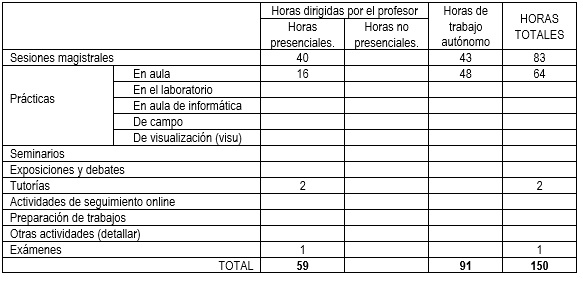INTERNATIONAL ORGANIZATIONS
GRADO EN ESTUDIOS GLOBALES/GLOBAL STUDIES
Curso 2023/2024
1. Subject Information
(Date last modified: 18-04-23 17:31)- Code
- 109013
- Plan
- 290
- ECTS
- 6.00
- Type
- Compulsory
- Year
- 2
- Duration
- First semester
- Language
- ENGLISH
- Area
- CIENCIA POLÍTICA Y DE LA ADMINISTRACIÓN
- Departament
- Derecho Público General
- Virtual platform
Professor Information
- Profesor/Profesora
- José Javier Laso Pérez
- Group/s
- Único
- Centre
- Fac. Derecho
- Office
- 229
- Office hours
- Lunes, martes, miércoles, de 12h.00 a 14h.00
- Web address
- http://campus.usal.es/~derechointernacionalpublico/profesorado/javier-laso-lopez/
- jjlasop@usal.es
- Phone
- 923294500 ext. 6963
2. Association of the subject matter within the study plan
Curricular area to which the subject matter pertains.
International Relations
Purpose of the subject within the curricular area and study plan.
This course aims to study the creation, functions and normative regime of international organizations (general part) as well as the regime of particular international organizations, with a special reference to the United Nations (UN) It is therefore essential in order to understand the legal order of International Organizations and complementary to others like EU law, Public International Law, International Relations and Diplomacy and Foreign Policy
Professional profile.
The course offers an essential training in skills related to the civil service, at various levels of the Public Administrations in International Organizations. The contents and techniques of this subject are also necessary in the training of any political scientist, civil servant of the administration, etc.
3. Prerequisites
It is recommended to have passed “International Relations” and “Public International Law” belonging to the first course of the Degree
4. Learning objectives
At the end of the course the student will have acquired a series of basic skills which will make him or her capable of developing a reflexing and critic attitude in relation to several problems and challenges that affect the International society, In concrete:
To be able to identify and explain the main defining characters of international organizations. .
To be able to show knowledge and understanding of the different types of organizations in order to grasp their political, economic and social contexts
To understand: the contents and limits of the International Organization legal status, both in international and domestic law; their different nature; and their main types.
To acquire and demonstrate a sound opinion on the studied Organizations and their activities.
5. Contents
Theory.
I. GENERAL PART
1.—HISTORY OF INTERNATIONAL OEGANIZATIONS. International cooperation and global governance.
2.- THE CONCEPT AND CLASSIFICATION OF INTERNATIONAL ORGANIZATIONS
-Definition and elements of International Organizations.
-Typology
3.- THE ROLES AND FUNCTIONS OF INTERNATIONAL ORGANIZATIONS-
International Organizations as instruments, actors and arenas
4.- THE LEGAL EXISTENCE OF INTERNATIONAL ORGANIZATIONS
The nature of International Organizations. International legal personality. Dissolution, succession, adaptation.
5.- INTERNATIONAL ORGANIZATIONS AND THEIR MEMBERS
Admission. Withdrawal. Expulsion, suspension and related techniques
6.- ORGANS OF INTERNATIONAL ORGANIZATIONS.
The structure of international organizations.
7. –INTERNATIONAL ORGANIZATIONS AS LAW-MAKERS
II.- UNIVERSAL ORGANIZATIONS
8.- THE UNITED NATIONS SYSTEM
The idea of the United Nations
Principal structure
9.- THE UNITED NATIONS IN ACTION
Peace and Security.
10. THE UNITED NATIONS IN ACTION. Decolonization.
11. THE UNITED NATIONS IN ACTION.
Human rights and development
12. THE INTERNATIONAL CRIMINAL COURT.
III. REGIONAL ORGANIZATIONS
13.- REGIONAL ORGANIZATIONS IN EUROPE
14. REGIONAL ORGANIZATIONS IN AMERICA
Practice.
The course will be offered using a combination of lectures and class discussions. The students are expected to prepare and debate the course materials in the class.
6. Competences acquired
Basic / General.
CB1, CB2, CB3, CB4
A1, A3, A4, A5
Specific.
B7, B11, B12, B13
7. Teaching methods
The proposed teaching method will be based on a combination of theoretical classes with a practical approach to the reality of international society. In doing so, dialogue with the students will be fostered with the aim of developing in them the ability to expose and defend reasoned arguments on international issues. Practical teaching will be based on the analysis of cases or the reading of texts that will be available on the Studium platform. It is advisable to keep abreast of the international news.
8. Anticipated distribution of the use of the different teaching methods

9. Resources
Reference books.
- KLABBERS, Jan: Advanced Introduction to the Law of International Organizations, Elgar Advanced Introductions series, Edward Elgar, Cheltenham, 2015.
- CONFORTI, B.; FOCARELLI, C.: The Law and Practice of the United Nations, 5th rev. ed., Legal Aspects of International Organization Vol. 57, Brill Academic Publishers, Leiden, 2016.
- KLABBERS, Jan: An Introduction to International Organizations Law, 3rd ed., Cambridge University Press, Cambridge, 2015.
- ARCHER, C. International Organization, 4th ed., London, Routledge, 2001
- HURD, I.: International organizations: politics, law, practice, Cambridge University Press, 2013..
10. Assessment
Assessment criteria.
The assessment instruments will be the following:
- Passing the exam. The modality of the exam will be a multiple-choice test (70 % of the final mark).
- Hand in the case studies and an active participation in practical and theoretical classes and seminars (30 %).
Guidelines in the case of failing the subject.
The requisites for the second exam are the same of those for the ordinary call.


